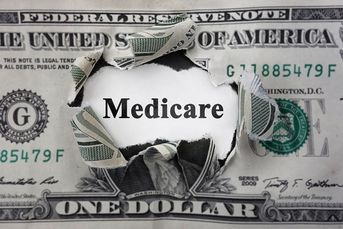What Medicare changes will mean for beneficiaries in 2017

By reevaluating supplemental and prescription drug coverages, Medicare enrollees can make up for premium increases.
Recently, I wrote about the estimated 22% escalation in Medicare Part B premiums and Parts B and D high-income surcharges. Contrary to what the Medicare Trustees projected, the Centers for Medicare and Medicaid Services (CMS) approved a 10% increase that will affect only 30% of all Medicare beneficiaries.
On top of that, the vast majority of current Medicare enrollees, approximately 70%, will not even pay a 10% increase in their Medicare Part B premiums. Why? Because of the statutory hold harmless provision. Given that that the 2017 Social Security COLA was only 0.3%, the hold harmless provision limits any increase in Medicare Part B premiums beyond any increase in Social Security benefits in a year. This rule is designed to protect most of the folks on Medicare from paying more for their coverage than their incomes can sustain.
Because of the hold harmless provision, the increase in Medicare Part B premiums is limited to a few dollars for 70% of the beneficiaries. On average, people in this category who currently pay $104.90 per month for Part B will pay $109 per month in 2017. The official announcement does not address Medicare recipients who entered new into Medicare last year and pay $121.80 and meet the hold harmless criteria.
It is not clear what their Medicare B premiums will be next. A strict reading of the CMS announcement could lead to the conclusion that those individuals might pay $109 per month. Until CMS issues further guidance, that question remains unanswered. It is possible that premiums for people who pay $121.80 per month currently may spend a few dollars more per month rather than less.
Medicare Part B enrollees who are not subject to the hold harmless will pay $134 per month. They include individuals who:
• do not receive Social Security benefits;
• enroll in Part B for the first time in 2017;
• are billed directly for Part B premium;
• are dually eligible Medicaid and Medicare and have their premium paid by state Medicaid agencies;
• pay high income-related premiums.
As if there is not enough confusion in Medicare, there will be at least two or three 2017 Medicare Part B premiums. They will vary based on what year the person started receiving Medicare Part B and whether they meet the hold harmless criteria. Individuals who entered into Medicare in 2015 or before will pay $109 per month. Folks who enroll in Medicare Part B in 2017 or are otherwise not held harmless will pay $134 per month. People who started Medicare in 2016 and meet the hold harmless criteria will either pay $109 per month or a little more than $121.80.
CMS also released the high-income 2017 Income-Related Monthly Adjustment Amounts (IRMAA) for Medicare Parts B and D surcharges. The following table includes monthly Medicare Part B premiums and Parts B and D IRMAA surcharges. Married couples who file their taxes singly have a slightly different income brackets and costs that are listed in this table.
| 2015 Medicare MAGI | Medicare B Premium & Surcharge | Medicare D Surcharge* | ||
|---|---|---|---|---|
| Single Filers | Joint Filers | Married Filing Single | ||
| ≤ 85,000 | ≤ $170,000 | ≤ $85,000 | $134 | $0 |
| ≤ $107,000 | ≤ $214,000 | NA | $187.50 | $13.30 |
| ≤ $160,000 | ≤ $320,000 | NA | $267.90 | $34.20 |
| ≤ $213,000 | ≤ $428,000 | ≤ $129,000 | $348.30 | $55.20 |
| > $213,000 | > $428,000 | > $129,000 | $428.60 | $76.20 |
Source: Dr. Katy Votava
Notes: 2015 Medicare MAGI = Adjusted Gross Income + Tax Exempt Interest. The new 2017 Medicare Part B premium $134 is used here. Some beneficiaries will pay less due to the hold harmless statute. *Medicare Part D IRMAA surcharges are separate from and in addition to the Part D plan premiums.
You might be thinking: Is there any good news here? Yes, there is. The good news is that most people can save much more than Medicare premium increases by reevaluating their Medicare supplemental and prescription drug coverages. We see many cases where folks can save $2,000 to $6,500 annually by changing their coverage. The primary culprit is that their current prescription drug plans are either not covering all of their medications or not doing so at the lowest total cost.
It is not too late for you to reevaluate your coverage. Even though Medicare Annual Enrollment ended earlier this month, Medicare Advantage plan enrollees get another bite at the apple from Jan. 1 through Feb. 14. That time frame is known as the Medicare Advantage Disenrollment Period (MADP). Medicare beneficiaries with Medicare Advantage can disenroll from that plan and enroll in a standalone Medicare Part D prescription drug plan.
I recommend you also consider enrolling in a Medigap plan at that time, because when you disenroll from your Advantage plan you will lose the supplemental benefits you had. You might find you save even more money by having a Medigap plan, particularly if you have had other high health care costs, i.e., medical equipment or out-of-network doctors.
It’s entirely possible you will have greater savings by changing your coverage compared to any increases in Medicare B premiums and surcharges.
Katy Votava, Ph.D., R.N., is president of Goodcare.com, a consulting service that works with financial advisers and consumers on health care coverage.
Learn more about reprints and licensing for this article.







